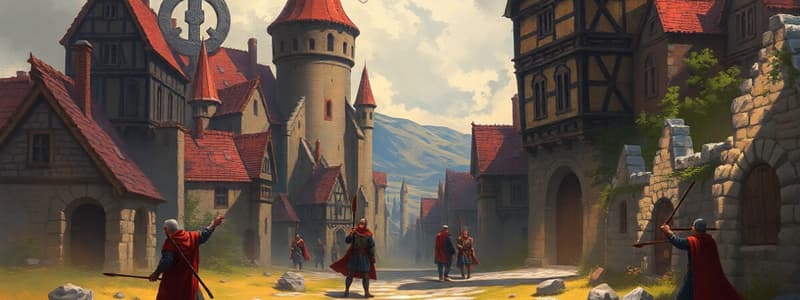Podcast
Questions and Answers
What characterized the Early Middle Ages after the fall of the Western Roman Empire?
What characterized the Early Middle Ages after the fall of the Western Roman Empire?
- The rise of various Germanic kingdoms and political instability. (correct)
- A flourishing trade network across Europe.
- The establishment of centralized monarchies throughout Europe.
- A unified political system dominated by the papacy.
Who was a prominent figure in the rise of the Frankish kingdom?
Who was a prominent figure in the rise of the Frankish kingdom?
- Louis IX
- Pepin the Short
- Clovis I (correct)
- Charlemagne
What major transition occurred during the High Middle Ages in Europe?
What major transition occurred during the High Middle Ages in Europe?
- A shift towards tribal governance systems.
- The dissolution of existing monarchies.
- Widespread urbanization and population growth. (correct)
- A significant decline in agricultural productivity.
What was a significant consequence of the Crusades during the High Middle Ages?
What was a significant consequence of the Crusades during the High Middle Ages?
What was one of the defining features of the Late Middle Ages?
What was one of the defining features of the Late Middle Ages?
How did the Late Middle Ages contribute to the rise of centralized monarchies?
How did the Late Middle Ages contribute to the rise of centralized monarchies?
Which technological advancement influenced warfare during the Late Middle Ages?
Which technological advancement influenced warfare during the Late Middle Ages?
What social change occurred as a result of the challenges to feudal order in the Late Middle Ages?
What social change occurred as a result of the challenges to feudal order in the Late Middle Ages?
Flashcards
Fall of Western Roman Empire
Fall of Western Roman Empire
The Western Roman Empire's decline and fragmentation, leading to political instability in Europe.
Feudalism
Feudalism
A system of reciprocal obligations between lords and vassals, shaping medieval political and social structures.
High Middle Ages Growth
High Middle Ages Growth
A period of European growth with population increase, agricultural advancements, and urbanization in the Middle Ages.
Black Death
Black Death
Signup and view all the flashcards
Hundred Years' War
Hundred Years' War
Signup and view all the flashcards
Medieval Universities
Medieval Universities
Signup and view all the flashcards
Stronger Monarchies
Stronger Monarchies
Signup and view all the flashcards
Medieval Trade Networks
Medieval Trade Networks
Signup and view all the flashcards
Study Notes
The Early Middle Ages (roughly 500-1000 CE)
- The fall of the Western Roman Empire led to a period of fragmentation and political instability.
- Various Germanic kingdoms emerged, adopting elements of Roman culture and administration.
- The Frankish kingdom, under figures like Clovis I, rose to prominence, eventually consolidating much of Western Europe.
- The papacy's influence grew, particularly in regards to religious affairs and establishing a power base in central Italy.
- Monasteries served as centers of learning and preservation of knowledge, copying and preserving texts from the classical period.
- The development of feudalism, a system of reciprocal obligations between lords and vassals, began shaping political and social structures.
High Middle Ages (roughly 1000-1300 CE)
- A period of significant growth and expansion across Europe. Population increased, and agriculture improved.
- The development of new technologies, like the heavy plow and three-field system, allowed for greater agricultural productivity.
- Urbanization occurred as towns and cities flourished, centers of trade and commerce.
- A burgeoning trade network across Europe and beyond, including the Hanseatic League, fostered economic development.
- The Crusades, a series of religious wars, involved European powers in campaigns to the Holy Land.
- Increased power of Royal monarchies occurred, though often in competition with the Church and nobility.
- The development and spread of Universities spread knowledge and education.
- Gothic architecture emerged in churches and cathedrals.
- Cultural flourishing seen in art, literature, philosophy.
Late Middle Ages (roughly 1300-1500 CE)
- The Late Middle Ages were characterized by crises and transitions.
- The Black Death ravaged Europe, significantly impacting population and economies.
- Social and economic upheaval resulted from the demographic crisis of the plague.
- Challenges to the existing feudal order grew as new social classes emerged.
- Political conflict and warfare, including the Hundred Years' War, became increasingly common.
- Developments in warfare, like the use of gunpowder, changed tactics and technology.
- The rise of strong, centralized monarchies in some regions challenged the power of the aristocracy.
- Increased religious dissent and reform movements emerged, contributing to the eventual Protestant Reformation.
- A shift from feudalism towards more centralized states and a market-based economy began during this period.
- Artistic and intellectual trends saw the emergence of humanism, a philosophy emphasizing human potential and achievements as a focus for culture and education.
Studying That Suits You
Use AI to generate personalized quizzes and flashcards to suit your learning preferences.




